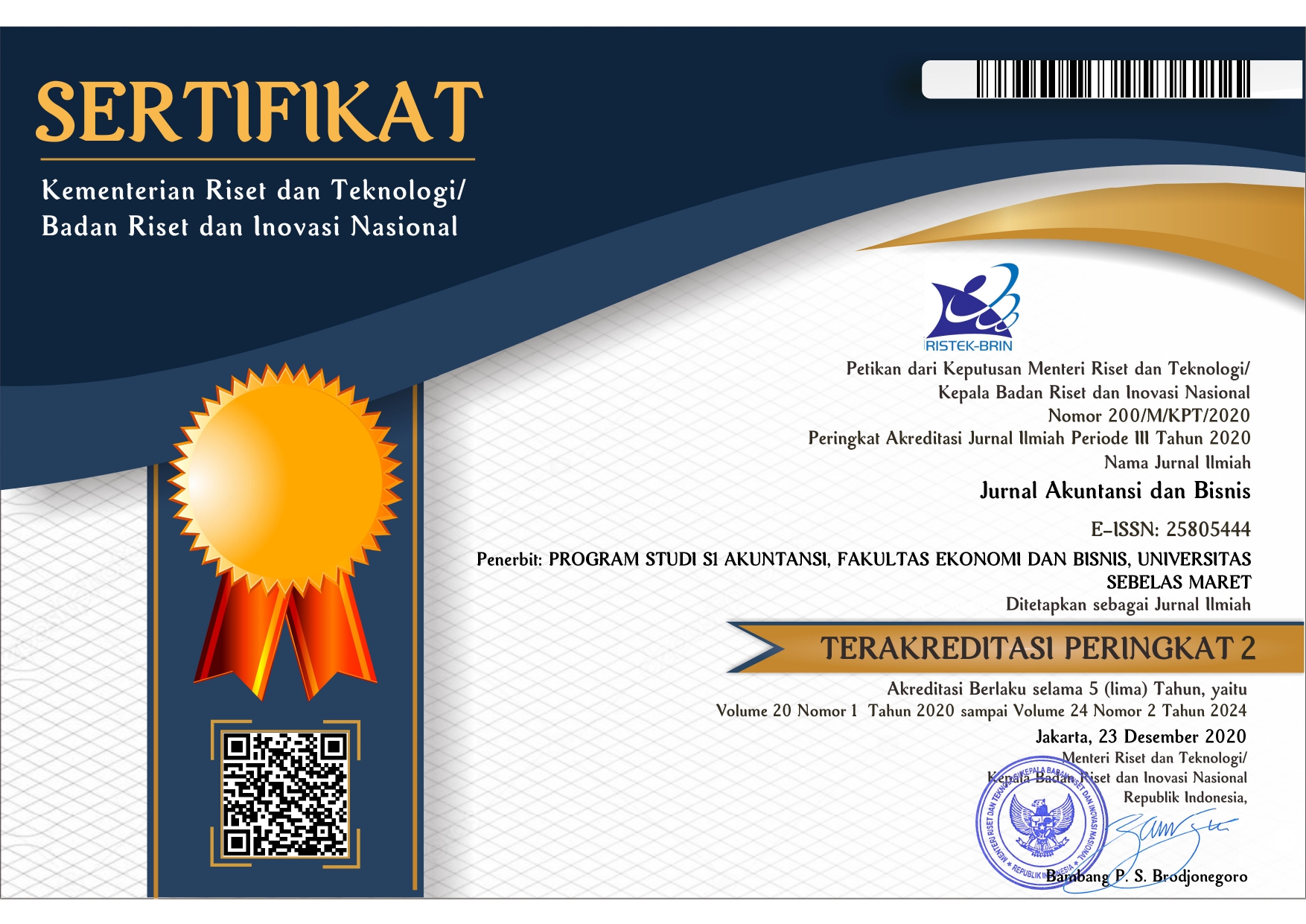Membentuk Softskill Mahasiswa Akuntansi melalui Effective Team Building dalam Ruang Kelas: Sebuah Aplikasi Mcgrath’s Model
##article.abstract##
References
American Institute of Certified Public Accounting (AICPA). 2005. AICPA Core Competency Frame Work for Entry into the Accounting Profesion. Available at : http://www .aicpa.org/edu/corecomp.htm.
Barrick, M., and M. Mount. 1991. The Big Five personality dimensions and job performance: A metanalysis. Personnel Psychology 44: 1-26.
Bateman, B., C., Wilson, and D. Bingham. 2002. Team effectiveness-Development of an audit questionnaire. The Journal of Management Development 21 (3): 215 – 226
Belbin, R. M. 1981. Management Teams: Why They Succeed or Fail. Oxford, U.K.: Butterworth Heinemann.
Bryant, S. M. 2001. A blueprint for an AIS consulting course. Journal of Information System 15 (1): 19-34.
Bryan, S., and Albrings. 2006. Effective Teams Building: Guidance for Accounting Educators. Journal of Accounting Education 21:241-265.
Burch, C. 1997. Creating a two-tiered portfolio rubric. English Journal 86:55-58.
Campion, J. J., G. Medsker, and A. Higgs. 1993. Relations between work group characteristics and effectiviness: Implocations for designing effective Work groups. Personnel Psychology 46: 823-850.
Cockriel, I. 2001. Forming instructional groups prom sociometric data: Educations 93 (4): 393-395.
Colbeck, C., S. Campbell, and S. Bjorklund.2000. Grouping in the dark: What College student learn from group projects. The Journal of Higher Educations 10: 95-111.
Cottel, P., and B. Millis. 1992. Cooperative learningin accounting . Journal of Accounting Education 10: 95-111
Danko, K., J. Duke, and D. Franz. 1992. Predicting student performance in accounting classes. Journal of Education for Business 270-274.
Dudley, M.2001. Speaking my mind. English Journal 90: 19-20.
Feictner, S., and E. Davis. 1992. Why some groups fail:A survey of student’ experiences with learning groups. In Collaborative Learnings: A Sourcebook for Higher Education, edited by A. Goodsell, M. Maher, and V. Tinto. University Park, PA: National Center on Postsecondary Teaching, Learning and Assesment.
Greenberg, J. 1996. Managing Behavior in Organizations. Upper Saddle River, NJ: Prentice Hall.
Grudnitski, G. 1997. A forecast of achievement from student profile data. Journal of Accounting Education 15 (4): 549-558.
Hackman, J.R. dan R. Wageman. 2005. A Theory of Team Coaching. Academy of Management Review, 30 (2): 269-297.
Hoevemeyer, V. 1993. How effective is your time? Training and Development (September): 67-71.
Holcomb, J., and R. Ruffer. 2000. Using a term-long project sequence in introductory statistics the American statistician 54: 49-53.
Jex, S. 2002. Organizational Pscyhology: A Scientific-Practitioner Approach. New York, JJohn Wiley dan Sons, Inc.
Katzenbach, J., and C. K. Smith. 1999. The Wisdom of teams: Creating the high Performance organization. New York, NY: HarverCollins Publishers, Inc.
Koppenhaver, G., and C. Shrader. 2003. Structuring the classroom for performance: Cooperative learning with instructor –assigned teams. Decisions Sciences 1 (1): 1-15.
Lancaster, K., and C. Strand. 2001. Using the team learning model in a managerial accounting class: An experiment in cooperative learning.Issues in Accounting Educatiuon 16(4) 549-567.
Latane, B., and S. Nida. 1980. Social impact theory and group influence: A social engineering perspective. In Psychology of group influence, edited by P. B. Paulus. Hillsdale, NJ: Lawrence Erlbaum Associates.
Lencioni, P. 2005. Yhe Five Dysfunctions of a Team: A Field Guid for Leders. Managers. And Facilitators. San Fransisco, CA: Jossey-Bass.
Margerison, C., and D. McCann. 1990. The Team Management Index. York U. K.: TMS Ltd.
Markel, M. 1998. Technical Communication: Situations and strategies. 5th edition. New York, NY: St. Martins Press.
McClough, A., and S. Rogelberg. 2003 Selection in teams: An exploration of team work knowledge, skills, and ability test. International Journal of Selection an Assessment 11 (1): 56 – 66
McGrath, J. 1964. Social Psychology: A Brief Introduction. New York, NY: Holt
Pelled, L., K. Eisenhardt, and K. Xin. 1999. Exploring the black box: An Analysis of work group diversity, conflict, and performance. Administrative Science Quarterly 44: 1 – 28
Ravenscroft, S., F. Buckless, G. McCombs, and G. Zuckerman. 1995. Incentives in student team learning: An experiment in cooperative group learning. Issues in Accounting Education 10 (Spring): 97 – 109.
Robbins, S. 1997.Essentials of Organizational Behavior. Upper Saddle River, NJ: Prentice Hall.
Siegel, G., and J. Sorensen. 1994. What Corporate Ameica Wants in Entry-Level Accountans. Montvale, NJ: The Institute of Management Accountans.
Speck, B. 2002. Facilitating Students’ Collaborative Writing. ASHE-ERIC Higher Education Report: Volume 28, Number 6. San Fransisco, CA: Jossey-Bass.
Wysocki, R. 2002. Building Effective Project Teams. New York, NY: John Wiley dan Sons, Inc.
DOI: http://dx.doi.org/10.20961/jab.v7i2.64
Jurnal Akuntansi dan Bisnis (JAB)
ISSN 1412-0852 (print), 2580-5444 (online)
Published by Accounting Study Program, Faculty of Economics and Business, Universitas Sebelas Maret, Indonesia

JAB on http://jab.fe.uns.ac.id/index.php/jab is licensed under a Creative Commons Attribution-ShareAlike 4.0 International License










